Most business professionals are familiar with the concept of the sales funnel – that visual representation of the journey a buyer takes, tracking the entire sales process, from lead to prospect to customer.
With the evolution of the Web, the sales funnel is evolving as well. Today, most buyers -- especially business-to-business (B2B) buyers -- do much of their purchasing research online, familiarizing themselves with a product or service and making some preliminary decisions long before ever contacting the seller.
The majority of the sales funnel has moved online, and sales teams have lost critical early access to prospects. In face the following research demonstrates that point as reported by sales teams for both B2B and B2C buyers.
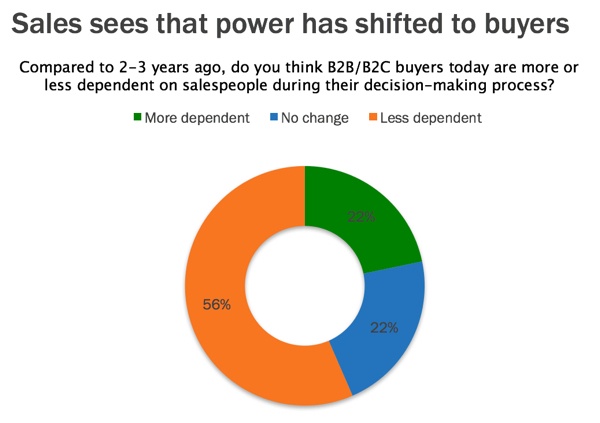
This fundamental change in buying behavior is forcing marketers to adapt their business development strategies to accommodate the increasing digitalization of the purchasing process.
Inbound marketing has become critical for marketers and essential for sales as a fundamental tool for regaining access to prospects early in the sale process.
Get your copy now to enjoy offline by completing the form to the right.
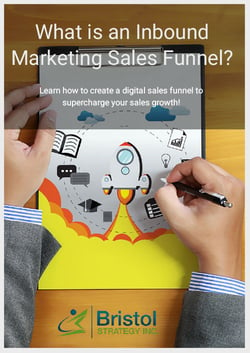
Before we launch into how the sales funnel is changing, let’s review the classic sales funnel approach and how it works. Because, while the tools used for moving prospects through the funnel are turning digital, the strategy behind it all remains the same.
In the classic sales approach, consumers were made aware of a product (for simplicity’s sake, we’ll use the term “product” to represent anything being sold -- either a physical product or a service) through advertising or public relations outreach. These conventional campaigns spread the word via general media to a passive audience that may or may not be interested in what’s being offered. From start to finish, the seller controlled the message as well as the channels of distribution.
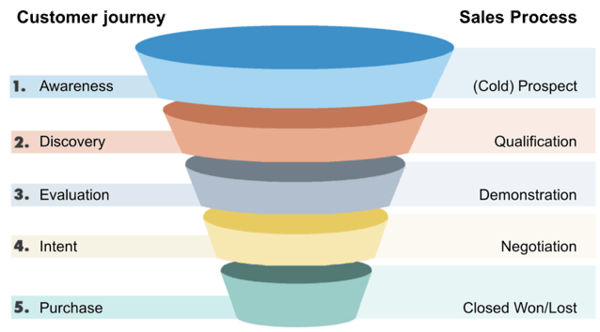
As consumers discovered a product, they would evaluate it, guided by information supplied by the business and its sales team. Interested prospects would then become qualified through their evaluation of the information and interaction with sales reps, who would then (hopefully) close the sale.
Typically there would be a single point of human contact – a marketing or sales person who would oversee the prospect’s journey through the funnel. With few contact options available, the sales person could more easily control the engagement. If prospects needed any additional information regarding the company and its products, they would have to get in touch with the sales rep.
Today, marketing and sales have lost control of how, where, and when prospects enter the sales funnel. Traditional advertising has lost its grip on consumers and the entire top portion the sales funnel has moved online. Controlled by the prospect, Awareness, Discovery, and Evaluation are taking place with little or no input from the seller other than their website and other available content they publish on the web.
Recently, inbound marketing has emerged as the de facto strategy for marketing online. Unlike traditional marketing which pushes generic messages out to a passive, mass audience, inbound marketing is focused on attracting interested prospects through relevant and helpful content that provides educational value and is personalized to them and where they are in their journey for information.
Inbound marketing is so-named because it uses high-value content designed to address the problems and needs of your ideal customer and “lure” them to your website. Prospects find you through online channels and tools, such as search engines, blogs, eBooks, and social media.
What makes inbound marketing so powerful is that your content reaches interested prospects when, where, and how they prefer, as they’re actively searching for a “cure” to their “pain.” The content created for each stage of the funnel automatically nurtures prospects by guiding them toward a discussion with sales.
The new, inbound marketing sales funnel helps capture the attention of prospects early in the sales cycle while they’re researching online. Eighty percent of all search traffic are queries to find information about a topic, including challenges consumers face such as “what product will make this problem go away?” By providing objective, educational information regarding that problem and possible solutions, you’re improving your chances of engaging that interested prospect, gaining their trust, and eventually their business.
To make this point, the chart below (from The State of Inbound 2017) shows that the number one problem for sales is getting a response from prospects. The number three item is identifying and prospecting good leads. Inbound addresses both by serving up warm leads to sales - prospects that want to speak to you. Inbound Marketing is a methodology to address these top problems.
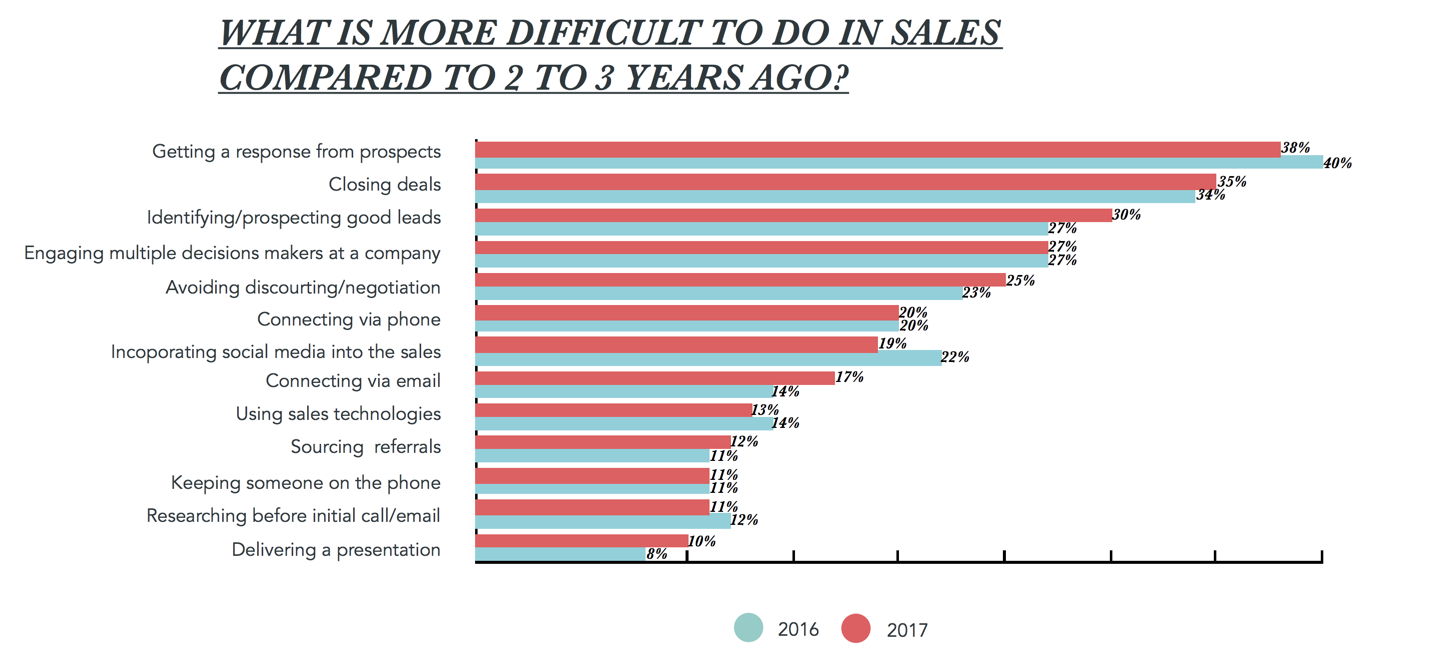
A prospect’s contact information is captured when they download your helpful content, they’re now enrolled into the inbound sales funnel, where automation (more on that below) feeds them additional information that aligns with their interests. This approach is necessary to nurture them down through the sales funnel until they are ready to engage with – and hopefully buy from – your your sales team.
This diagram shows the three stages of the inbound sales process from the perspective of the website visitor. They are seeking solutions to their problems, from first becoming aware of it - to considering solutions you offer - to making a decision about which solution to implement.
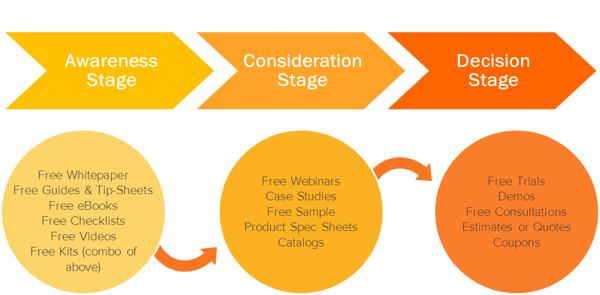
Awareness, at the top and the widest part of the funnel, is designed to attract a large number of leads. As we all know, sales is a game of percentages. The journey from lead to customer winnows out the unlikely and the uninterested, leaving a significantly reduced number of prospects, but ones with a greater likelihood of becoming customers.
The awareness stage creates visibility for the marketer and attracts the attention of leads. It answers questions, establishes trust, and begins to create value for prospects.
Consideration is the next stage of the buyer’s journey. Here, leads are qualified by providing product and service information and answering basic brand-related questions. The conversion process from lead to customer begins here because by converting on a conversion-stage offer, the prospect is providing a behavioral cue that they are researching your company. They are clearly "considering" your business.
The consideration-stage email nurturing addresses any pushback and remaining causes of hesitation with the goal of leading the prospect to request a call with your business.
Decision is where the marketing team hands off prospects to the sales team because the prospect has asked for contact with a knowledgeable sales representative from your company. The prospect is by now a warm lead.
The funnel diagram below shows the buyer's journey on the left, the marketing tactics on the right to address the visitor's needs at each buyer's journey stage, and the tools that enable an automated sales process in the center. We will describe how to put this automated funnel into practice below.
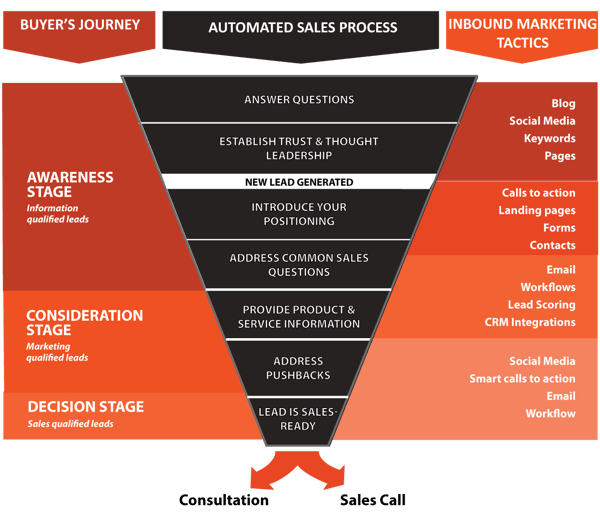
The critical element that optimizes an inbound strategy and creates efficiencies unmatched by traditional outbound methods is automation. Marketing automation makes it possible to customize communications in a way that hits every prospect with the right message at the right time, making it ideal for supporting the sales process.
Providing content for each stage of the buyer's journey and automating delivery of custom, personalized content based on the visitor's interest enables the seller to regain more control at the top of the funnel where differentiating your offering versus your competition.
 Automated email nurturing based on prospect behavior gives sales and marketing teams with important insight into how their audience is engaging with their content – the forms they fill out, content they download, and web pages they visit.
Automated email nurturing based on prospect behavior gives sales and marketing teams with important insight into how their audience is engaging with their content – the forms they fill out, content they download, and web pages they visit.
These engagement details make a significant difference in the quality of your outreach because each individual prospect and their needs are put into context so your outreach to them is much more effective.
Marketing and sales teams use automation to nurture the prospect with effective content sent at a time that resinates with each prospect.
Needless to say, automation is what amplifies the value of your sales and marketing team and helps your business grow.
As your marketing automation adds prospects into your sales funnel, it’s vital that they meet a piece of appropriate content at each stage of their journey to address their needs.
At the top of the funnel, content should be focused on identifying a major challenge the majority of your prospects face that you can address. Here you’re creating awareness and thought leadership based on your buyer persona (more on that in a minute).
By demonstrating that you understand their “pain” and might have a “cure” for it, you’re showing expertise that has value for potential buyers. Make sure you have a premium offer such as an eBook or white paper attached to your content as a call-to-action (CTA). Within that premium content should be another offer that nudges them to the next stage.
The next diagram shows how to implement an automated inbound marketing sales funnel. The blog content on the left (Awareness) is attracting visitors by covering many elements of the visitor's problem. The first eBook is an in-depth review of the problem the buyer is trying to solve by offering solutions. The automation described above shows how to automate the nurturing emails that is answering common questions and the consideration (branded) eBook in the center of the diagram. Once the visiter is researching how you solve the problem and downloads the consideration content, the same automation nurtures to the decision state by answering the common objections buyers may have.
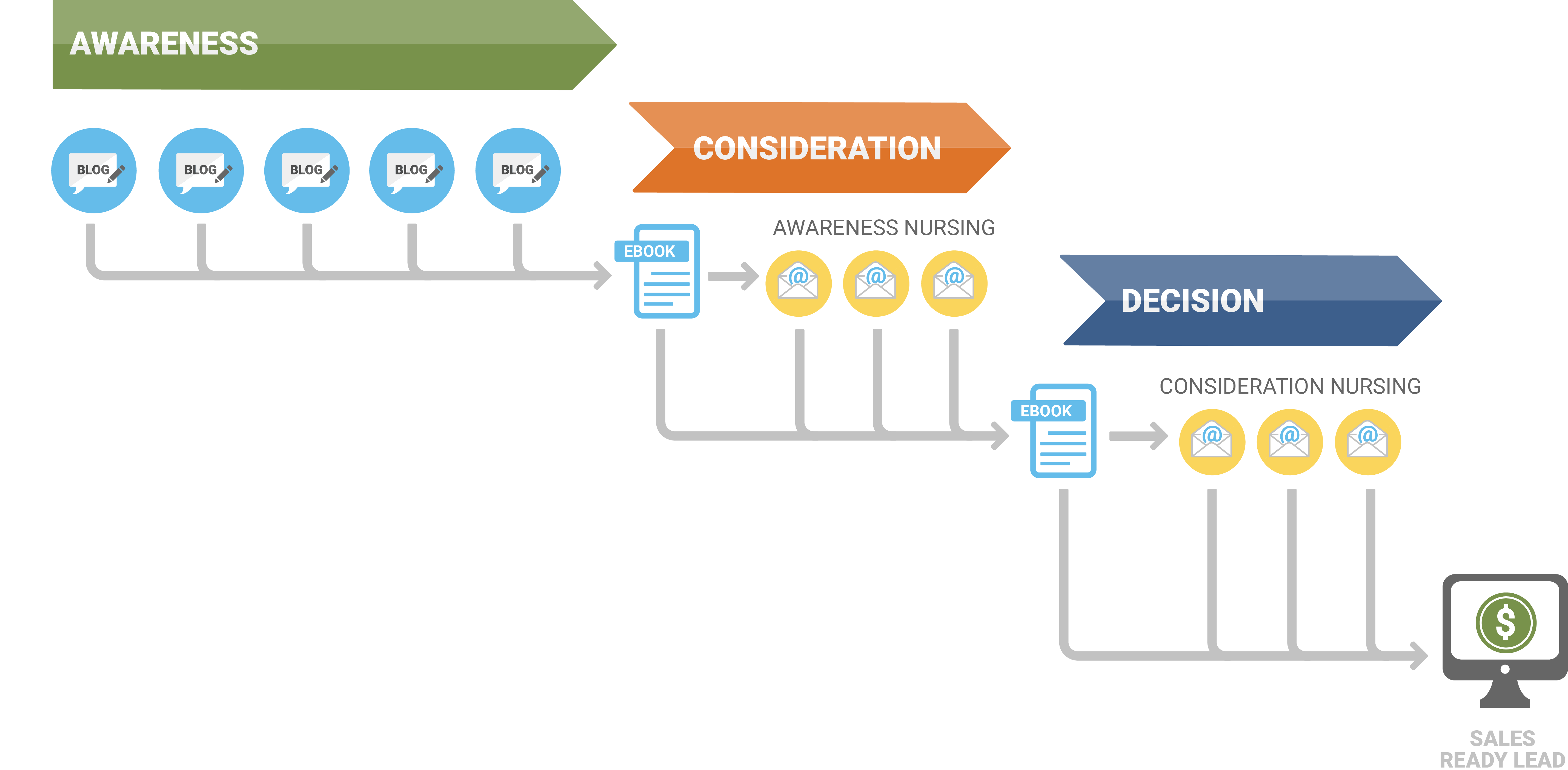
Throughout the entire journey through the funnel, nurturing emails are a critical tool to support downloaded content. For example, if an eBook is downloaded, schedule emails that address potential questions that might arise regarding its topic and counter any potential pushback early on. Use your marketing automation platform to detect which stage they are at and automatically push content to them to guide them down the funnel.
For inbound marketing sales funnels to work they must incorporate targeted content, user behavior monitoring, and data analysis. Once again, content that aligns with each stage of the journey is the trigger and the catalyst that converts and nurtures prospects.
The cardinal rule governing the content creation process is know thy customer. This requires establishing an ideal buyer persona – a profile of the perfect prospect’s job description, challenges, requirements, and desires. An accurate buyer persona enables you to truly understand why individuals buy – and don’t buy. Without buyer personas, your marketing efforts aren’t as specific and targeted as they should be. You’re wasting time, effort, and money on unprofitable segments of the marketplace and promotions, while failing to fully invest in the customers who matter the most.
While you may have an idea of who your target customers are, how can you be sure that you’re reaching them effectively if you haven’t taken the time to identify what’s important to them and what they need? If you need more convincing, here’s a cautionary case study from computer security giant Norton:
Norton’s antivirus software was well known – infamous, really – for slowing down computers. For some reason, the company did not feel compelled to fully research market perceptions and preferences to create a buyer persona. When it announced a new release, it decided to promote how well the software stopped viruses, even though the new version was faster. The campaign sputtered and failed.
Stung by defeat, the company decided it should invest the time and effort to look more closely at its market and the individuals most likely to buy its antivirus software. Norton’s research revealed that its application was universally perceived as slow and quickly rejiggered the marketing message to highlight the antivirus solution’s faster speed. As a result, the company saw significantly improved campaign results.
How big a flag you’re able to raise on the web directly affects the number of leads who will find your website and your content. Optimizing that content is crucial for creating an effective sales funnel.
It starts with high-quality content on your website, filled with keyword terms that align with your buyer persona preferences. However, it’s important to be aware that the traditional view of “keywords” in search has changed. Where a few years ago there were perhaps 10-20 “big keywords” that would be sought after for ranking within a topic, there are now hundreds or thousands of long-tail variations that are regularly searched within a topic and changed based on location.
Simply attempting to dominate a few words is no longer enough to produce successful results. Today’s search engines are remarkably smart. They know if your answer to a search has satisfied searcher intent. They use sophisticated analytics to look at how long visitors spend on certain web pages and their patterns of click-throughs. The results are then used to rank content and either promote or demote search results.
What will help your search results is posting “content clusters” – blocks of content based around related topics important to your buyer persona. By posting clusters instead of disparate, individual posts, you’ll be positioned to capture a large amount of search traffic across an ever-increasing pool of relevant keywords while providing enough content depth to satisfy searcher intent. The strategy behind creating a topic cluster content program is to enable deeper coverage across a range of core topic areas.
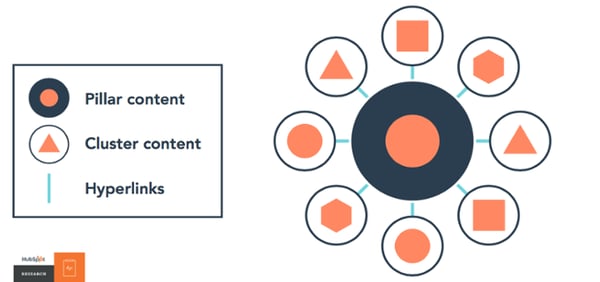
If your website has a low domain authority it takes more time for it to rank for the content you’re publishing. As you publish, the domain authority rises, along with the ranking of your content. Think of it this way: “a rising tide floats all boats.” Likewise, having a number of inbound links coming to your site from other, relevant sites helps build domain authority by convincing search engines that your site must be valuable because other sites are linking to it.
Beyond the importance of keywords for SEO is the potential stumbling block of technical SEO errors. Unlike the marketing decisions that influence keyword choice and how well you rank in searches, technical SEO errors inhibit search engine crawlers from properly indexing your website, potentially blocking your site from ranking at all. Fortunately, there are tools that you can use to analyze your website for technical SEO errors. Create a technically-clean website and you are well on your way to success. Tools like SemRush and Moz are good options for marketers.
The rules have now fundamentally changed for the buying process and sales cycle. Buyers are now firmly in control, often ignoring traditional advertising channels and actively searching for product or service information online to make an informed purchasing decision with little or no input from the seller.
Fortunately, there is a silver lining for marketers to this new paradigm. Inbound marketing provides a new avenue for reaching the modern buyer on their own terms – providing valuable, objective information that can gently guide the buyer into a relationship with the seller without the taint of “advertising.” Inbound marketing creates warm leads who see value in what you have to offer and want to engage with you.
But inbound marketing is only half of the battle. Once leads become prospects they need to be turned into customers and that requires the modernized version of the sales process – inbound sales. Here’s where automation really shines. To create a seamless contact/convert/customer cycle through automation, you actually need two kinds of software solutions: marketing automation software to attract leads, coupled with customer relationship management (CRM) software to build and nurture relationships once the sale is closed. Integrating these two solutions helps bridge the gap between marketing and sales, making the hand-off smoother, more efficient, and more effective.
The diagram below shows the different stages of the relationship for inbound sales (on the right) versus inbound marketing (on the left).
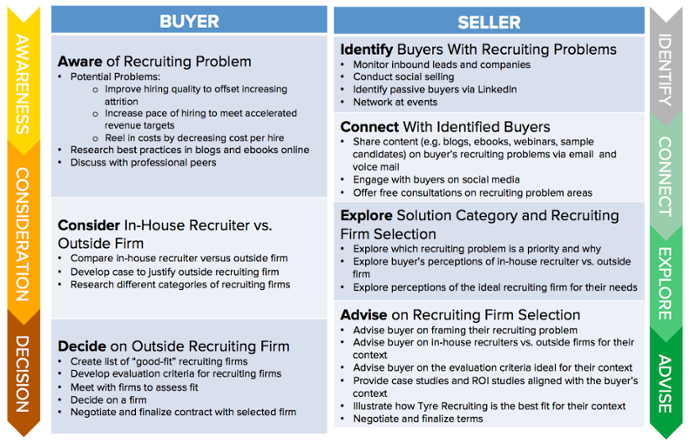
Inbound sales draw on the same philosophies as inbound marketing because inbound sales addresses the wants and needs of the buyer first – what inbound solutions provider Hubspot calls “solving for the customer” -- compared to traditional outbound sales techniques that focus instead on seller goals and objectives. Inbound salespeople personalize the entire sales experience to the buyer’s perspective by researching their needs and offering value with each interaction.
Just as inbound marketing creates content for a particular buyer and specifically for each stage of the buyer’s journey for information (Awareness, Consideration, Decision), inbound sales takes care to understand the buyer by mapping out the buyer’s sales journey and considering his or her focus at each stage of the journey through the inbound marketing sales funnel.
By puzzling out the buyer's actions in the inbound marketing process, the smart inbound salesperson will be able to craft a sales approach personalized to the buyer's interests. However, the inbound sales methodology is a complete change of thinking for most sales teams. It requires a lot of research into each prospect. However, the payoff is significant because the time invested has been to identify and develop highly qualified prospects and the approach taken by inbound sales representatives provides a substantial advantage over the typical, traditional outbound sales approach.
Get your copy now to enjoy offline by completing the form to the right.

Businesses should recognize that the buyer behavior has moved online. The sea-change in the purchasing process and the buyer/seller relationship can no longer be ignored. To attract buyers, businesses must shift their tactics online, too. That means investing in marketing automation and targeted content to effectively meet prospects online and guide them through the new digital marketing and sales funnel.
Once the digital funnel is in place, it works for your business 24 hours a day 365 days per year. It's like creating a digital clone of your best sales rep. One that doesn’t eat, sleep, or take time off. Inbound marketing and sales is not only efficient, it’s the future.
Ready to get started? Let’s talk.
Ask us about our unique approach that creates a full-funnel "inbound" engagement model for your business that attracts and converts digitally engaged prospects.